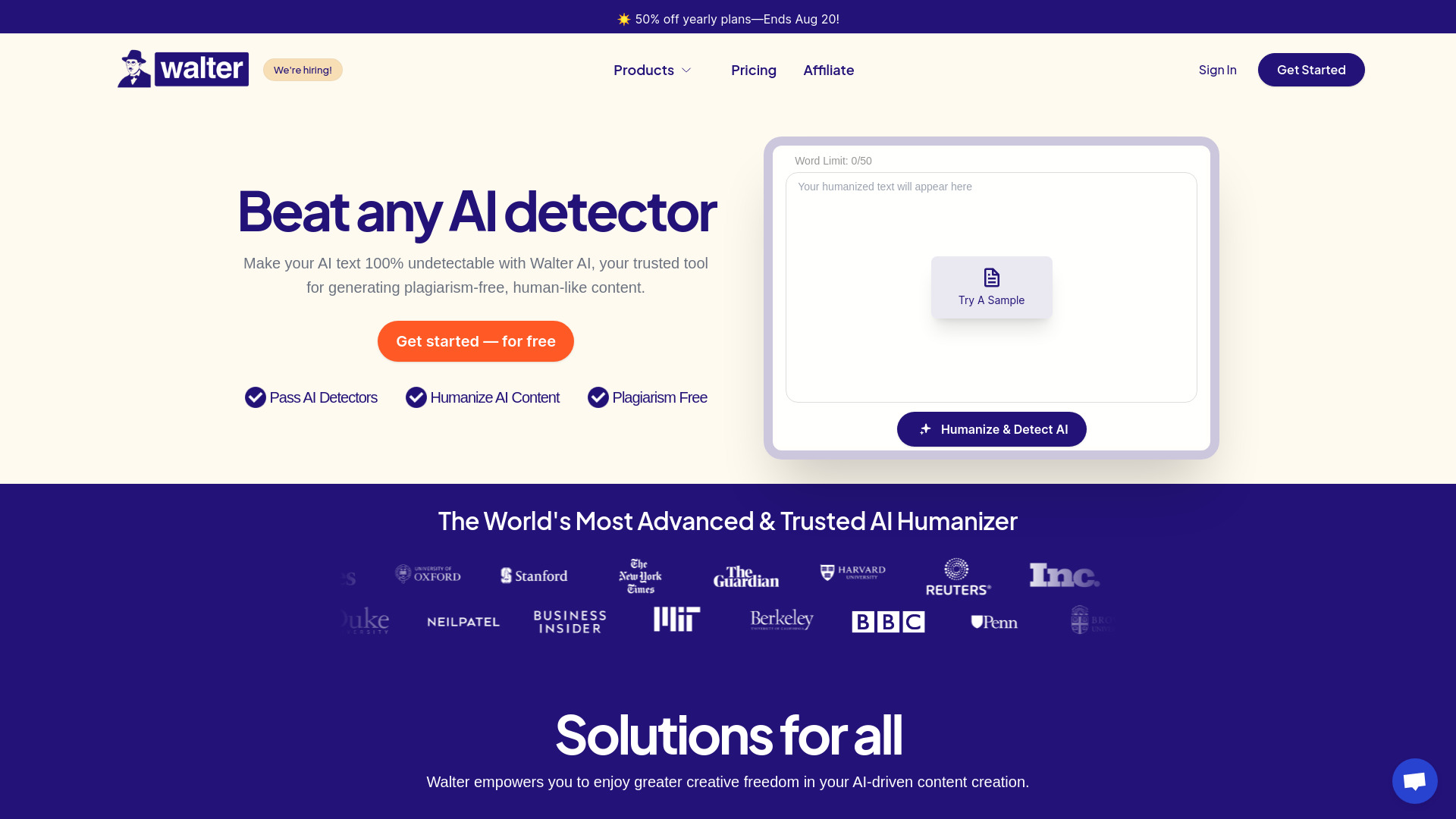- Home
- AI Detector
- Walter Writes AI

Walter Writes AI
Open Website-
Tool Introduction:AI humanizer for natural tone, originality checks, and clarity.
-
Inclusion Date:Oct 21, 2025
-
Social Media & Email:
Tool Information
What is Walter Writes AI
Walter Writes AI is an AI content humanizer and detection assistant that helps transform AI-generated drafts into natural, reader-friendly prose while promoting originality and integrity. It analyzes text for machine-like patterns often flagged by AI detectors (such as Turnitin or GPTZero) and offers context-aware rewrites, tone adjustments, and clarity edits so your writing reads authentic and audience-appropriate. Paired with plagiarism awareness and ethical guidance, it supports students, researchers, and professionals in producing clear, credible content.
Walter Writes AI Key Features
- Humanize AI text: Rewrites sentences to improve cadence, vary structure, and adjust vocabulary and tone so the prose feels naturally written by a person.
- AI detection insights: Flags passages with AI-like signals and explains why they may be classified as machine-generated, guiding responsible revisions.
- Originality support: Encourages citation, attribution, and source integration to help maintain plagiarism-free, authentic writing.
- Style and clarity editing: Refines grammar, coherence, and readability to match purpose and audience without distorting meaning.
- Ethical safeguards: Provides best-practice prompts and reminders to follow institutional and publisher policies regarding AI assistance.
Who Is Walter Writes AI For
Ideal for students and academics polishing assignments, theses, and manuscripts; content writers and marketers refining AI-assisted drafts; professionals preparing reports and client deliverables; and editors or educators who need quick feedback on AI-likeness to coach revisions and uphold integrity standards.
How to Use Walter Writes AI
- Paste or upload your draft into the workspace.
- Select a goal (e.g., Humanize or Detect AI signals) and choose tone or audience preferences.
- Run analysis to surface AI-like patterns and readability issues.
- Apply suggested rewrites, fine-tune tone, and preserve your intent and voice.
- Add citations where needed and verify originality before finalizing.
- Review against your institution or client’s AI usage policy; include disclosure if required.
- Export or copy the revised text for publication or submission.
Walter Writes AI in Industry
In higher education, students and writing centers use it to revise AI-assisted drafts into clearer, properly cited work that aligns with academic integrity rules. Marketing teams streamline blog posts and landing pages by humanizing AI outlines into brand-aligned copy. Corporate communicators refine policy memos for clarity and tone, while editors use detection feedback to guide contributors toward more natural, credible prose.
Walter Writes AI Pros and Cons
Pros:
- Improves readability, tone, and natural flow of AI-generated drafts.
- Provides AI detection insights to reduce machine-like patterns responsibly.
- Supports plagiarism-free writing with citation and originality guidance.
- Saves time by combining rewriting and detection feedback in one place.
- Helps align outputs with audience expectations and editorial standards.
Cons:
- No tool can guarantee undetectability; AI detectors evolve and can produce false positives or negatives.
- Over-rewriting may unintentionally change nuance if edits aren’t reviewed carefully.
- Excessive dependence on automation can mask underlying gaps in research or argument quality.
- Users must ensure compliance with institutional and publisher policies regarding AI assistance.
Walter Writes AI FAQs
-
Does Walter Writes AI guarantee content will not be detected as AI-generated?
No. Detection systems change frequently and can misclassify text. Use the tool to improve clarity and authenticity, not to evade policies.
-
Is content produced with Walter Writes AI plagiarism-free?
The tool supports originality, but you are responsible for citing sources and contributing your own ideas. Always verify attribution before submission.
-
Is it allowed for academic submissions?
Policies vary. Check your institution’s guidelines on AI assistance and disclose usage when required.
-
How is it different from a basic paraphraser?
It combines humanization with detection insights and ethical guidance to help you revise responsibly rather than simply reword text.
-
Can it replace human editing?
It accelerates revision, but human review remains essential for accuracy, tone, and compliance.



